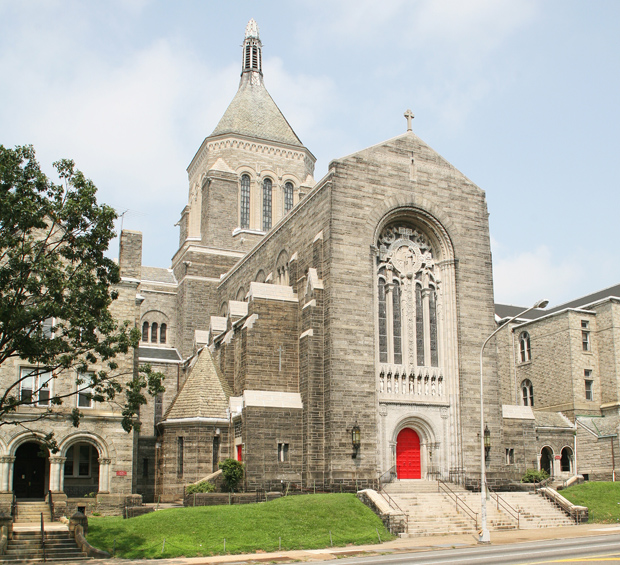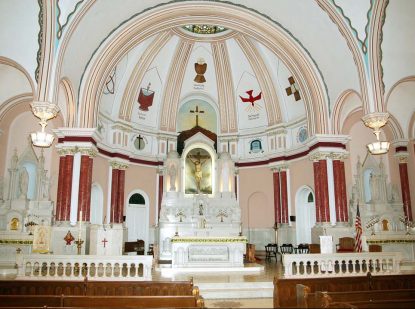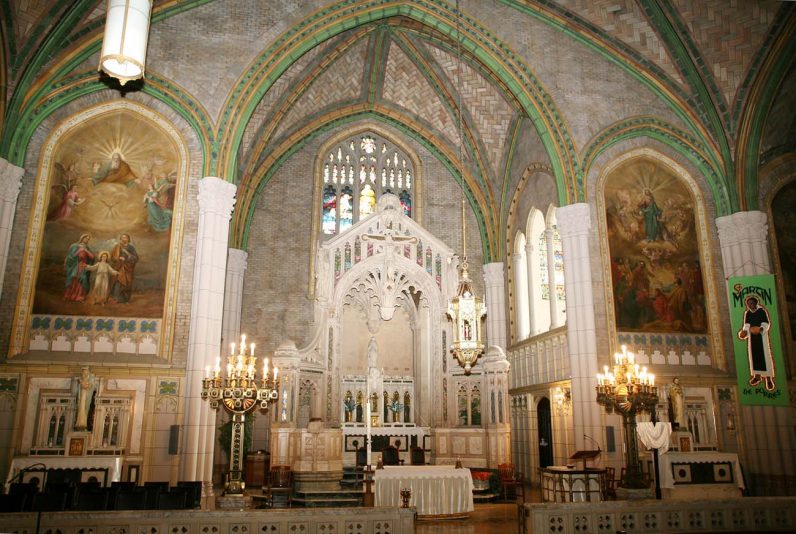
Our Lady of Hope Parish, located at 5200 North Broad Street in North Philadelphia at the site of the former Holy Child Church, became the new spiritual home for Catholics of the area after a 1993 parish merger.
Several archdiocesan parishes have or will celebrate a milestone anniversary of their founding this year. Three of them celebrating their 25th anniversary – Our Lady of Hope and St. Martin de Porres in North Philadelphia and St. Katharine Drexel in Chester – were born out of painful circumstance.
On April 2, 1993, the Archdiocese of Philadelphia stunned the local community when it announced it was closing or combining 12 parishes in North Philadelphia and six of the seven parishes in Chester into one, with the seventh combining with a parish in Clifton Heights, Delaware County.
They weren’t the first parishes ever to close in the archdiocese, of course, but most previous closures were because a parish’s area had become less residential and closings were done one at a time. The 1993 closures were mostly because their territory had become not necessarily less residential but less Catholic.
The greatest single factor at that time was white Catholics moving to suburbs and being replaced in the area by mostly non-Catholic African Americans.
[hotblock]
Under the 1993 closings, in North Philadelphia Our Lady of Pompeii Parish, an Italian national parish founded in 1914, merged into St. Veronica Parish, as did St. Bonaventure, founded in 1889. St. Elizabeth Parish, founded in 1872, merged into newly founded St. Martin de Porres at the site of the former St. Columba, which was founded in 1895. Most Precious Blood, founded in 1907 also merged into St. Martin De Porres.
Gesu Parish, founded in 1868, merged into St. Malachy, although its church remains as a chapel for St. Joseph’s Preparatory School.
Holy Child, founded in 1909; Our Lady of the Holy Souls, founded in 1909 and St. Stephen, founded in 1843, all merged into a new parish, Our Lady of Hope at the site of Holy Child.
St. Henry, founded in 1916 as a German national parish, merged into Incarnation of Our Lord, founded in 1900; Incarnation itself merged into St. Helena in 2013. St. Edward, founded in 1865, merged with Visitation B.V.M. at the site of that church in Kensington.
The most drastic move was in the City of Chester, where St. Anthony of Padua (Italian), founded in 1908; Immaculate Heart of Mary, founded in 1873; St. Michael, founded in 1842; Resurrection of Our Lord, founded in 1911 and St. Robert, founded in 1922, all merged into the new Blessed (now St.) Katharine Drexel Parish at the St. Robert site.
St. Hedwig (Polish), founded in 1902, became a worship site of Sacred Heart, Clifton Heights.
Now it’s a quarter century later, so how are the combined surviving parishes doing?
A comparison of parish registration figures from the following year, 1994 to 2016 (the most recent figures posted online) generally show a decline for the surviving parishes.
St. Malachy has dropped in registration from 932 to 460. St. Martin de Porres has dropped from 1,218 to 1,000; Visitation from 6,173 to 5,618; St. Helena from 5,470 (10,274 if you include the 1994 Incarnation figure) to 2,478; St. Veronica from 7,600 to 164; Our Lady of Hope from 1,686 to 1,098; St. Katharine Drexel from 3,911 to 992 and Sacred Heart from 1,863 to 833.
[tower]
But parish registrations are not always what they seem. Not everyone calls the rectory when they move in or move out or when their children have moved away.
Probably a better indicator of the health of the parish is the number of people who attend Mass and the number of children baptized. It is especially noteworthy if baptisms outnumber funerals, which does usually happen in the city parishes these days.
Also, parishes that are near a college or university or hotels may have deceptively high Mass attendance by non-residents. There are Catholics who choose to worship in a non-parish setting, for example at a monastery, convent hospital, nursing home or school, and they are not counted in parish attendance.
There are also instances of undercounts in registration, perhaps most noticeable in the parishes with a Hispanic majority.
Looking at the figures for St. Veronica, which showed 164 on parish rolls, “actually it’s about 400,” said Father Joseph LoJacono, I.V.E., who has been pastor this past year.
The parish has about 800 attending Mass on a given weekend, and Father LoJacono believes there are really about 20,000 Latinos in the area, many of them immigrants, but unchurched or being proselytized by evangelical or Pentecostal groups who often have an anti-Catholic message.

The interior of St. Veronica Church, located at 6th and Tioga Streets in North Philadelphia.
“We have conducted several missions and will have another this summer,” he said, adding he was fortunate to have the presence of religious sisters working in the parish, among them Sisters of the Immaculate Heart, Sisters of St. Joseph and Servants of the Lord and the Virgin of Matara.
Another surviving parish from the 1993 mergers that shows a high Mass attendance is St. Helena, located in the Olney section of lower Northeast Philadelphia. Attendance for a typical weekend was 1,351 in 2016 or 55 percent of registration, and again, there is a large multi-national immigrant population.
“The parish is doing very well,” said Msgr. Joseph Trinh, St. Helena’s pastor. “We’ve just completed a review of the past 20 years. We are the only parish in our area that still has a school. We have Masses in three languages — English Spanish and Vietnamese — and we have good attendance.”
For the archdiocese as a whole the 2016 Mass attendance was 222,371 or 20 percent of registered parishioners, according to the published report. The “October count” figure is based on actual head counts of successive Saturday evening/Sunday Masses at all archdiocesan parishes for four weeks in October 2016.
This contrasts with the 1995 Mass attendance figure when October counts were new at 389,316 or 31 percent, a figure that was considered extremely low at that time.
[hotblock2]
Going back even further, according to Msgr. James F. Connelly’s 1976 “The History of the Archdiocese of Philadelphia,” although there were not October counts, in his Quinquennial Report of 1963 to the Vatican, Archbishop John Krol stated of the 1,309,307 Catholics in the archdiocese “only 5 percent neglected their Easter duty.”
He reported 190,873 child baptisms over the previous five years, which contrasts with the 59,342 infant and child baptisms shown in archdiocesan reports for the comparable period 2012-16.
In fairness, 1963 was a watershed year, the last year of the pontificate of Pope John XXIII, the convener the Second Vatican Council which generated world-wide favorable reviews and good feelings to the Roman Catholic Church.
Much has happened since, including external cultural changes and internal self-inflicted scandals.
But these old numbers give us something to shoot for. With prayer, missionary zeal and God’s help, they can be replicated.

The interior of St. Martin de Porres Church, located at 24th Street and Lehigh Avenue in North Philadelphia.
PREVIOUS: Disabilities don’t stop woman from serving at the altar for 25 years
NEXT: You are invited to the ordination of six new priests this Saturday



The Chester parishes merged into the Saint Robert site not Resurrection.
This story has been corrected to reflect this information. We regret the error; thank you for pointing it out. — Editor
Having an explanation of why the churches in Chester, PA, closing gives me clarity on the closings. Being born in Sacred Heart Hospital in Chester and baptized in St. Michael’s as well as attending St. Michael’s School, receiving my First penance before First Holy Communion and Confirmation. In the time I was educated at St. Michael’s the only thing we girls had to complete about besides our grades was the length of our hair. I feel the pain as a Mother for the work of the serpent who claims the spirit of the children who have been killing other children. I can only pray for my grandchildren to graduate without harm.
Upon reading the article I was taken back in time when all the Parishes were in their heyday of the early 1960s to the time of the individual closings of the churches. I remember well the first stage appearance at St. Robert’s auditorium as Sleepy from Snow White, Monte Carlo night at St. Michael’s. I could write all day of the wonderful memories of having the privilege of being a parishioner and educated in St. Michael’s. I would love to know what became of my Sister’s Of St. Joseph who taught us. The first lay teacher was a surprise and shock for all of us. We were so fortunate to have the opportunity to learn from the cream of the crop about our Lord Jesus Christ. Even though I was very young when Father Higgins turned towards us speaking English. The progression from Chior music to the introduction of the guitar during mass was a very exciting time in the Mother Church everywhere.
I am and always will be proud of being born a Catholic to Catholic parents who made sure all 10 of we children were instilled with the love of God and to reciprocate the same love to Him.
I would love to see a photo series of all Philadelphia Catholic churches, even the ones that are no longer open. It would be a great momento. Thanks.
Dear Lou, I join Father Thorne in thanking you for this article. He keeps encouraging me to write down what I remember. I was stationed in North Philadelphia for twenty years, 1963 to 1983. There were many closures before the mergers that you mention; the ethnic parishes, Our Lady of the Blessed Sacrament (Broad Street) African-American, Saint Ludwig, German, Saint Ladislaus, Polish and Saint Mary of the Eternal, Italian. There were three territorial parishes which were mostly African-American, Assumption, Our Lady of Mercy and Corpus Christi. In 1963 at Saint Elizabeth, 23rd and Berks Streets, we had two Children’s Masses at 9:30 on Sundays in the Upper and Lower Churches. While a significant population relocated, I really believe that many Catholics of North Philadelphia, mostly African-American, have been lost to the Church.
Msgr. Pashley
Thanks Lou! I know all of these parishes well. I was baptized and raised at Our Lady of the Holy Souls. I was assigned as a newly ordained priest at Blessed Katharine Drexel in 1998. I am blessed to serve as the pastor of Saint Martin de Porres Parish in North Philadelphia, a great Faith Family!
Father Thorne